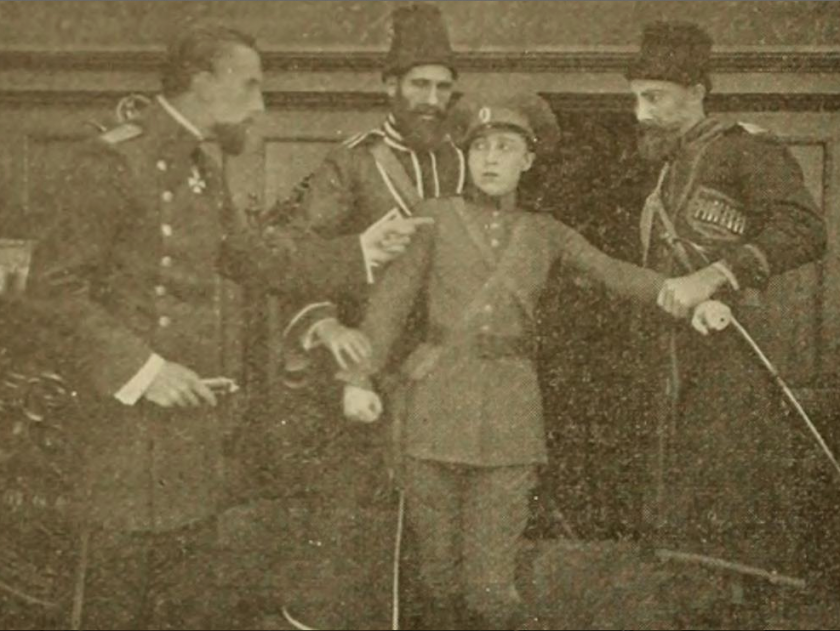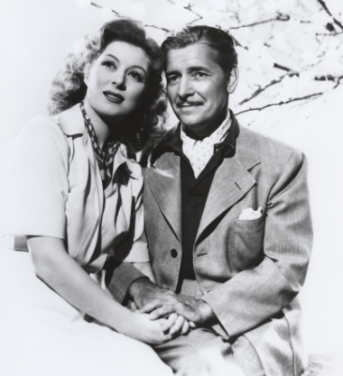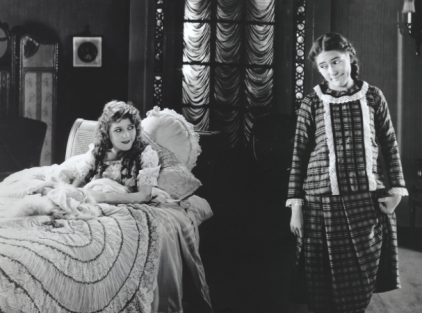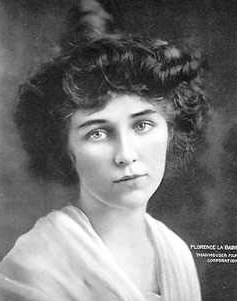
One hundred years ago this week, Grace Kingsley paid a visit to the set of an unusual big-budget war film, Legion of Death:
Hup Forward—march! No, it wasn’t any sturdy captain of the Sammies who gave the command, but a slim slip of a woman—Edith Storey, and she was giving her command to still other slim slips of women, a whole drove of them, clad in neat khaki and managing to look like real soldiers instead of chorus girls as one might fear…
Right into a trench Miss Storey marched her feminine cohorts, and then—the battle began. And those girls knew how to use their rifles and bayonets! It was a marvelous sight. They fought like demons with their mock enemies; and pretty soon their pretty caps were all askew, there were actual bloodstains on their faces, and a very real gleam of battle lust in their eyes.
Writer June Mathis (Ben-Hur, Four Horsemen of the Apocalypse) based Legion on the first women’s combat battalion in modern history. Kingsley said they were planning “a powerful drama of a Russian woman patriot and the formation of the now famous ‘Battalion’ which undoubtedly saved Russia from German invasion during the revolution that shook the world’s largest empire from end to end and resulted in the overthrow of the Romanoff dynasty.”
Kingsley talked to the director, Tod Browning, and just like De Mille and Griffith, he emphasized the lengths they were going to for authenticity in his epic film. An army lieutenant trained the actresses to march and carry arms properly. They weren’t allowed to wear wigs: they had to cut off their hair, just like the soldiers did (these clever ladies made the producers pay their salaries before their hair was shorn). Browning demanded real Russian people as extras for the big street and battle scenes; they were so authentic that they didn’t speak any English so he had to hire seven translators. Danny Hogan, the Chief of Properties, couldn’t find what he needed for a Russian palace in stores, so he borrowed a carload of furniture from the Italian Ambassador. All of this added up to “a feature which promises to be the most timely, unique and spectacular picture which Metro has even produced” according to Kingsley.
All of their realism didn’t extend to the story, of course. Edith Storey played a princess with a love interest who founds the group, gets captured after a defeat, but is freed to live happily ever after. The real Battalion was proposed by Maria Bochkareva, a decorated front-line fighter who was born to a peasant family. Her goal was to shame Russian male soldiers who were tired of fighting Germans after three years. Minister of War Alexander Kerensky agreed, and allowed Bochkareva to train and lead 300 female recruits as the First Women’s Battalion of Death. They were sent to the front where they were resented by the male soldiers. Even though they performed well in combat, Bochkareva had to disband the unit after a few months because they were treated so badly by their fellow troops. She wrote a memoir in 1919 called Yashka, My Life as Peasant, Officer and Exile. She was executed by the Soviet secret police in 1920. You can read more about the Battalion on the History Buff blog.
Kingsley didn’t get to review the finished film, but her co-worker Antony Anderson thought it was “a Metro triumph.” The reason you may have never heard of this epic is because it’s a lost film. A new version of the story, Batalon, was made in Russia in 2015.
The Legion/Battalion was so famous at the time that they got mentioned in a much more lighthearted story Kingsley reported this week. Actor Jack Mulhall was in a downtown L.A. department store trying on a ladies corset for an upcoming role, and he told her:
just as they had me all trussed up in a twin-six, ball bearing, 1917 model steel cage somebody yelled fire…Miserable as I was, I forgot all about the corset and made a dash for the street. Outside I met a friend. “What’s the idea?” he demanded gazing at the corset which I had tried on over my trousers and shirt, “going to war?” Just then along came a girl I knew, and I instantly decided I preferred cremation to meeting her, so back I dashed to the corset department. Yes, I’ve worn ‘em in three scenes now—and, believe me, I don’t know that the Legion of Death was making so much of a sacrifice when it took of its corsets and went to war!
The film was called Madame Spy, and it concerned a young man who goes undercover as a baroness to learn the secrets of a German spy ring. Exhibitor’s Herald thought “Jack Mulhall as an impersonator of the fair sex is quite good,” but the story was padded (February 9, 1918).
Kinglsey had a happy surprise while watching her favorite film this week, The Co-respondant: the heroine acts with “straightforward sensibleness uncommon in screen heroines” and the hero “contrary to all screen ethics, behaves like a sensible human being.” The film told the story of a star woman reporter (Elaine Hammerstein*) who, in her youth, was almost dragged into an illicit relationships with a ‘rounder.’ Now the cad’s wife has named her as the co-respondent in her divorce case. Complications, including a libel case, false identity and threats of ruin ensue, but her current love (Wilfred Lucas) believes her side of the story implicitly and fights the cad as soon as he can, while the heroine types it up for an article. Kingsley said:
it is a picture play of such tense and deep-rooted human drama that in the development of its big central situation you sit quite breathless; yet it is played so naturally, there is such an utter lack of forced situation, its train of events is so entirely logical, one seems to be looking on a cross-section of life itself. Maybe you don’t believe this. I don’t blame you if you do not; but just go to the Superba and see for yourself.
You can’t go to the Superba Theater any more, but a fragment of the film exists at the Library of Congress.


Kingsley mentioned that J.A. Quinn, the owner of Quinn’s Rialto Theater, announced that the new Mae Marsh film Sunshine Alley would absolutely play for only one week, and he’d add midnight showings on the last days if needed. Curious, I had a look at the Rialto ads to see if he did. They didn’t tell me: I had completely forgotten that in 1917, films ran continuously and the audience came in whenever they wanted to. So I wondered when film ads in the LA Times began to include starting times. Except for some Cinerama shows, it wasn’t until 1962! So if you really want to re-create the film going experience of earlier times, pick a random chapter on your DVDs and start there.
*She was the songwriter’s cousin.





































